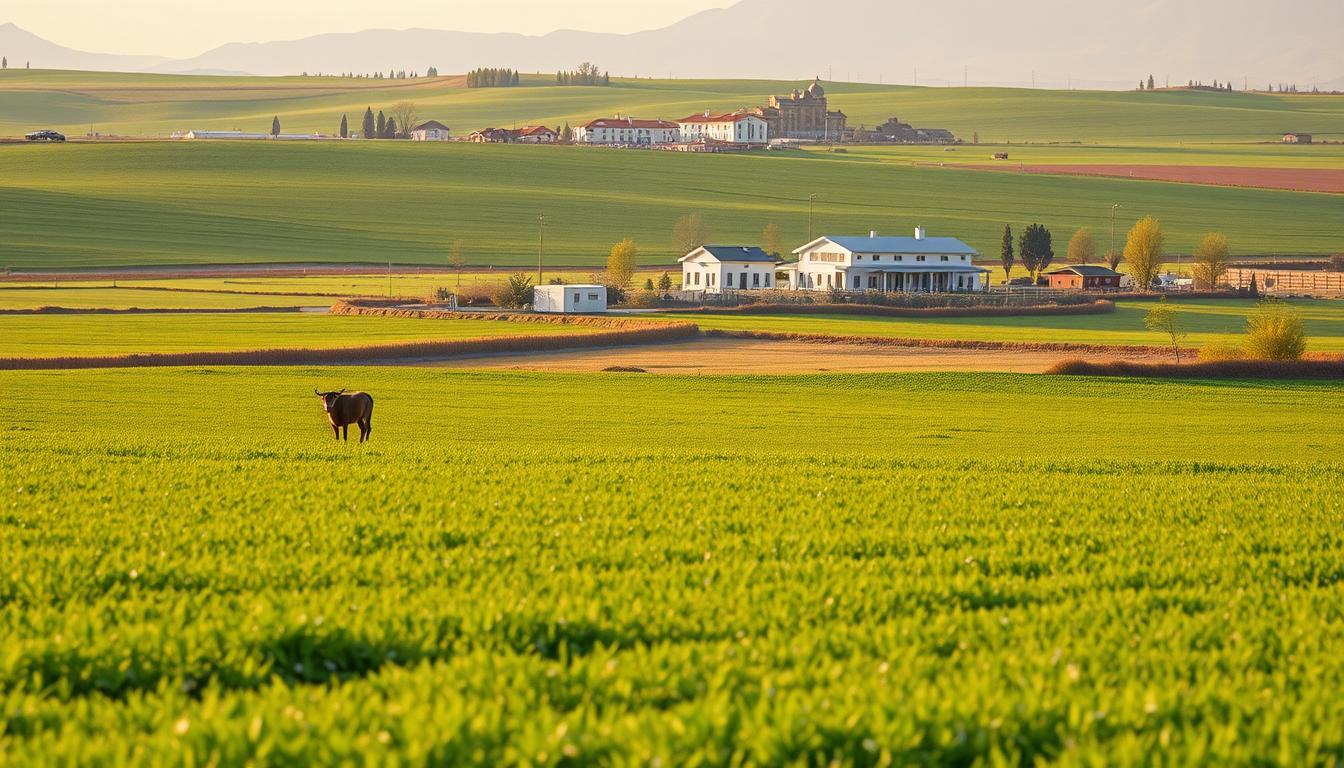How can a country in Central Asia claim to be debt-free while sitting on vast natural wealth? Turkmenistan, a nation often overlooked, presents a fascinating case study. Its government proudly touts a model built on resource abundance and financial independence. But is this narrative as solid as it seems?
Turkmenistan’s economy heavily relies on gas exports, which account for a significant portion of its revenue. This dependence has created both opportunities and vulnerabilities. While the government emphasizes its debt-free status, critics point to underlying challenges, including currency crises and social impacts.
This article delves into the sustainability of the so-called “Turkmen model.” Can it withstand global market fluctuations and internal pressures? By examining its strengths and weaknesses, we aim to uncover the truth behind this unique approach.
Key Takeaways
- Turkmenistan claims a debt-free status due to its resource wealth.
- The country relies heavily on natural gas exports for revenue.
- Official narratives often contrast with economic realities.
- Currency crises and social challenges pose significant risks.
- The sustainability of the “Turkmen model” remains under scrutiny.
Introduction to the Turkmen Economic Model
Turkmenistan’s economic framework stands as a unique case in Central Asia. Emerging from the Soviet Union’s collapse, the country transitioned into an authoritarian, resource-based system. This shift laid the foundation for its current financial structure, heavily reliant on natural gas exports.
The government has invested heavily in symbolic nation-building. Monumental construction projects, such as the capital’s marble-clad buildings, reflect its vision of grandeur. These efforts aim to project stability and progress, both domestically and internationally.
However, contradictions abound. While official statistics report a 6.5% GDP growth in 2017, international organizations like the IMF and World Bank have suspended data verification. UNCTAD data reveals that consumption constitutes only 11% of GDP, compared to 49.1% from investments.
This imbalance highlights the system’s reliance on external funding rather than internal development. The problems faced by the Turkmen government are evident in various reports that indicate a significant disparity in life in Turkmenistan, with cases of conflict arising from economic instability.
“The social contract in Turkmenistan revolves around subsidies in exchange for political compliance.”
Despite its gas wealth, 60% of the people live below the poverty line. This disparity underscores the challenges of wealth distribution. The 2014 energy price collapse further exposed systemic vulnerabilities, raising questions about the model’s sustainability.
| Indicator | Turkmenistan | Regional Average |
|---|---|---|
| GDP Growth (2017) | 6.5% | 4.2% |
| Consumption as % of GDP | 11% | 35% |
| Population Below Poverty Line | 60% | 25% |
Turkmenistan’s economic model remains a subject of debate. While it showcases resilience, its reliance on gas exports and authoritarian governance presents significant risks. Understanding this framework is crucial to assessing its future trajectory.
The Role of Natural Gas in Turkmenistan’s Economy
Natural gas plays a pivotal role in Turkmenistan’s financial structure. The country holds the fourth-largest global gas reserves, making it a key player in the energy market. However, this abundance comes with problems, particularly in diversifying its export markets and improving life in Turkmenistan for its people.
The turkmen government faces challenges in managing these resources effectively, and media coverage often highlights these issues.In 2009, Turkmenistan lost access to Russian and Iranian markets due to pricing disputes.This forced the nation to pivot toward China, which now accounts for 94% of its gas exports. In 2017 alone, Turkmenistan exported 33.6 billion cubic meters of gas to China.
Gas Export Dependency
Turkmenistan’s reliance on gas exports has created significant vulnerabilities. Between 2014 and 2017, gas prices plummeted from $503 to $266 per tonne. This decline was exacerbated by oil-linked pricing in Chinese contracts, which tied gas prices to volatile oil markets.
As a result, revenue from gas exports has been inconsistent. This instability has made it difficult for the government to maintain financial stability, especially as foreign currency reserves are drained to repay Chinese loans.
China’s Influence on Turkmen Gas Exports
China’s involvement in Turkmenistan’s gas sector began with $8.1 billion in loans between 2009 and 2011. These loans were tied to resource-for-credit deals, requiring repayment in gas exports.
While this provided immediate funding, it has locked Turkmenistan into a long-term dependency on China, complicating the life in Turkmenistan and leading to various problems for its citizens, including women, who face unique challenges in this economic landscape. This situation highlights the need for more information on how countries like Turkmenistan can navigate their economic dependencies and improve their official rate of financial stability.
This arrangement mirrors Chinese debt traps seen in Venezuela and Angola, where resource-rich nations struggle to repay loans. For Turkmenistan, this has led to a significant drain on its foreign currency reserves, further complicating its economic stability.
| Indicator | Turkmenistan | China |
|---|---|---|
| Gas Exports (2017) | 33.6 bcm | 94% of total exports |
| Gas Price Decline (2014-2017) | $503 to $266/tonne | Oil-linked pricing |
| Chinese Loans (2009-2011) | $8.1 billion | Resource-for-credit deals |
Turkmenistan’s reliance on gas exports and its relationship with China highlight the challenges of building a sustainable economic model. While gas reserves provide a foundation, diversification and strategic planning are essential for long-term stability.
Currency Crisis and Economic Stability
A growing currency crisis has put pressure on Turkmenistan’s financial system. The devaluation of the manat and the disparity between the official exchange rate and the black market have created significant challenges for the people of Turkmenistan. These problems highlight deeper vulnerabilities in the country’s economic framework over the years, providing critical information about the ongoing issues affecting life in Turkmenistan.

Devaluation of the Manat
In 2015, the government devalued the manat from 2.9 to 3.5 manat per usd. This move was followed by the suspension of currency convertibility in 2016. The devaluation aimed to stabilize the foreign currency reserves but instead led to increased inflation.
Imports of dollar-denominated goods saw a staggering 294% inflation rate. This spike severely impacted businesses and consumers, further straining the economy.
Black Market Currency Exchange
The black market has thrived due to strict currency controls in Turkmenistan. At its peak in 2018, the unofficial rate reached 30 manat per usd, compared to the official exchange rate of 3.5. This disparity has fueled corruption, particularly within security services, affecting the life of the people in the country.
This data illustrates the challenges faced by citizens during this year.Citizens have faced challenges accessing foreign currency, with the state capturing dollar savings and blocking remittances. These measures have eroded public trust and exacerbated economic instability.
“Currency controls have created a parallel economy, where the black market dictates the real value of the manat.”
Priority projects like the TAPI pipeline and the Asian Games have further drained reserves. These initiatives, while symbolically significant, have diverted resources from critical economic needs.
| Indicator | 2014 | 2016 |
|---|---|---|
| Current Account Deficit (% of GDP) | 5% | 21% |
| Annual Debt Repayment to China | $1 billion | 30% of reserves |
The currency crisis underscores the need for reforms. Without addressing these systemic issues, Turkmenistan’s economic stability remains at risk.
Social Impacts of Economic Policies
Economic policies in Turkmenistan have far-reaching effects on its population, shaping daily life and opportunities. While the government emphasizes resource wealth, many citizens face significant challenges. Rising poverty, unemployment, and emigration trends reveal the human cost of these policies.

Rising Poverty and Unemployment
The dismantling of the free utilities subsidy program in 2017 marked a turning point for many households. Combined with an estimated 294% inflation on essential goods, the cost of living has skyrocketed. This has pushed a large portion of the population into financial hardship.
Public sector layoffs and delayed wage payments have further exacerbated the situation. Many citizens struggle to secure stable income, leading to widespread discontent among the people of Turkmenistan.
In peripheral regions, food rationing systems have become a necessity, highlighting the severity of the crisis as it affects the quality of life in these countries. This is part of a larger trend impacting the nation.Emigration Trends
Faced with limited opportunities, many Turkmen citizens are choosing to leave the country. Age-based travel bans targeting those under 40 have not deterred this trend. Emigration hubs like Turkey and Russia have become destinations for those seeking better life prospects.
In Turkey, many find work in construction, while in Russia, the service sector offers employment. However, the repression of dollar-based informal economies has made it difficult for families to rely on remittances. This has strained household security and deepened economic instability.
“The social contract, once based on subsidies in exchange for political compliance, has been violated, leading to growing unrest.”
These social impacts underscore the need for reforms. Without addressing the root causes of poverty and unemployment, the stability of Turkmenistan remains at risk.
Government Response to Economic Challenges
Facing mounting economic pressures, Turkmenistan’s leadership has implemented controversial measures. Public investments now constitute 41% of GDP, focusing on grandiose infrastructure projects. Critics label this approach “Potemkin economics”—prioritizing optics over sustainable development.

Public Investment Programs
The government channels funds into showcase projects like marble-clad buildings in Ashgabat. These symbolize progress but divert resources from critical needs. A 2022 power consolidation abolished the upper parliament house, centralizing authority under Berdimuhamedov.
Key flaws in this system include:
- Militarized crisis responses (travel bans, cyber surveillance).
- Nepotism in Serdar Berdimuhamedov’s political ascension.
- Failed import substitution industrialization attempts.
Social Security Reforms
In 2023, the government replaced subsidies with moral policing laws. Dress codes, alcohol bans, and anti-polygamy rules aim to enforce security through control. This shift has drawn criticism for ignoring rising poverty.
“Social contracts now prioritize compliance over welfare, eroding public trust.”
These reforms reflect a reactive economy struggling to balance stability with development. Without addressing systemic issues, long-term viability remains uncertain.
Geopolitical Influences on Turkmenistan’s Economy
Geopolitical dynamics significantly shape Turkmenistan’s economic landscape. The nation’s strategic location in Central Asia makes it a focal point for regional and global powers. Two key players, China and Russia, exert considerable influence, each with distinct interests and strategies.

China’s Economic Dominance
China has emerged as Turkmenistan’s primary economic partner, driven by its energy needs and the vibrant life in Turkmenistan. The Central Asia-China Gas Pipeline network is a cornerstone of this relationship, highlighting the importance of collaboration between countries. In 2017, China accounted for 36% of Turkmen gas imports and 13% of its total consumption, a significant part of the overall economic information for that year.
This partnership extends beyond energy. Between 2009 and 2011, China provided $8.1 billion in loans, tying repayment to gas exports. This resource-for-credit model has deepened Turkmenistan’s dependency on China, with $9 billion in foreign debt matching estimated loan exposure.
“China’s Belt and Road Initiative (BRI) has cemented its influence, making Turkmenistan a key node in its ‘Five Corridors’ plan.”
Russia’s Role in the Region
Russia remains a significant player, leveraging its historical ties and security influence. The Kremlin has proposed security assistance contingent on gas cooperation, reflecting its strategic interests in the Caspian region.
However, Russia’s approach has been cautious. Analysts describe it as a “wait-and-see” strategy, particularly in light of potential regime instability. This contrasts with its more active stabilization role in Kazakhstan during the 2022 unrest.
| Indicator | China | Russia |
|---|---|---|
| Gas Imports (2017) | 36% | Limited |
| Loan Exposure | $9 billion | N/A |
| Strategic Focus | Energy, BRI | Security, Gas |
The interplay between these two powers creates both opportunities and challenges for Turkmenistan. Balancing their interests while pursuing economic independence remains a complex task.
Future Prospects for Turkmenistan’s Economy
Turkmenistan’s future hinges on its ability to navigate complex economic and geopolitical challenges that directly impact life in Turkmenistan. With declining reserves and external threats, the nation faces critical decisions.
Strategic reforms and diversification are essential to ensure stability and growth for the people of Turkmenistan, as this information is vital for understanding the broader implications on life in Turkmenistan.Potential for Economic Reform
Reforms are crucial to address systemic vulnerabilities. Reserves coverage has fallen from 30 months in 2015 to 20 months in 2017, signaling a need for immediate action. The IMF projects a 2.3% GDP contraction if reforms stall, highlighting the urgency.
Key areas for reform include:
- Diversifying export markets beyond gas.
- Addressing currency instability and black market activity.
- Implementing policies to attract foreign investment.
Without these changes, the risk of a state collapse looms, especially with threats from Taliban and ISIS-K in Afghan border regions.
Long-term Economic Sustainability
Sustainability depends on balancing resource wealth with strategic planning. The TAPI pipeline, targeting completion by 2024, could boost gas exports. However, delays or failures could further strain the economy.
Green hydrogen production offers a promising avenue for diversification. Leveraging renewable energy could position Turkmenistan as a leader in sustainable energy. Yet, this requires significant investment and technological advancements.
Demographic challenges also pose risks. Youth emigration trends threaten to create a labor shortage, undermining long-term growth. Addressing these issues is vital for stability.
| Indicator | 2015 | 2017 |
|---|---|---|
| Reserves Coverage (Months) | 30 | 20 |
| GDP Contraction (IMF Projection) | N/A | 2.3% |
| Youth Emigration Rate | Moderate | High |
Turkmenistan’s future will depend on its ability to adapt. Strategic reforms, diversification, and addressing demographic challenges are essential. Without these steps, the nation risks economic instability and geopolitical vulnerability.
Conclusion
Turkmenistan’s wealth in natural resources contrasts sharply with its governance challenges. While the country boasts vast reserves, its government struggles to translate this into broad-based development. This paradox highlights systemic inefficiencies that threaten long-term stability.
China’s role as a key partner cannot be overstated. Its influence extends beyond energy deals, shaping the nation’s economic trajectory. However, reliance on Beijing raises questions about sovereignty and security, especially with $9 billion in liabilities tied to Chinese loans.
Regional instability adds another layer of risk. A potential state collapse could have far-reaching consequences, destabilizing Central Asia. The people bear the brunt of these challenges, facing rising poverty and limited opportunities over the years, which significantly affects the quality of life in Turkmenistan.
Reforms are imperative for the post-Berdimuhamedov era. Diversifying the economy, addressing governance failures, and fostering sustainable development are critical steps. Without these changes, the future remains uncertain.
FAQ
▶
▶
▶
▶
▶
▶
▶
▶
▶
▶














